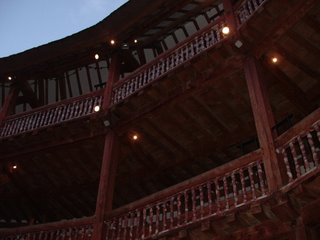


Top left is a gallery at the Globe. Right - Apsley House and below the view outside the Globe site
A record of Carol and Len's time in England




This is an unusual place. Not only because it has survived since 1119, but, with many and disparate owners, it became a grand home for an American heiress to the Standard Oil fortune who lived there from 1926 until her death in 1974.
The castle has Norman foundations,a mediaeval gatehouse,the Gloriette built by Edward 1st and update in Henry VIII's times, a Tudor tower and a 19th century country house. The bay window shown above was installed by Henry VIIIth.
In 1926 Olive,Lady Baillie, together with her husband Arthur Filmer bought the castle and embarked upon a lavish refurbishment using the finest French architects and designers to create an elegant country residence. On her death she left the castle to the Leeds Castle Foundation, a private charitable trust whose aim is to preserve the castle and grounds for the benefit of the public forever.
It is extensively used for weddings, conferences and banquests. There are 24 bedrooms most of which have bathrooms reflecting the modern necessities of a great country house. I did think about booking this for the potential wedding of my daughter but thank God she has not made such a commitment!
The extensive grounds and gardens have several lakes which are the home to hundreds and hundreds of water birds. These include black swans which were imported from Australia. There is an aviary which houses several endangered bird species, a falconry, a grotto, a maze. All set in majestic parklands. This is a truly remarkable and memorable place to visit.
The day we chose to visit also turned out to be the day on which there was a Food and Crafts fair, which probably accounted for the hordes of people and near full car parks. Housed in large marquees there was an amazing array of craftwork, food and drink and fortunately we had forgotten to get some actual cash to take with us, so that purchasing was strictly limited!!





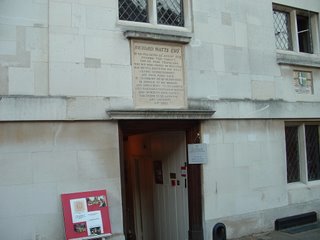
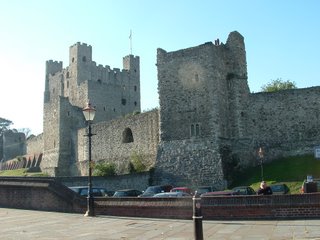
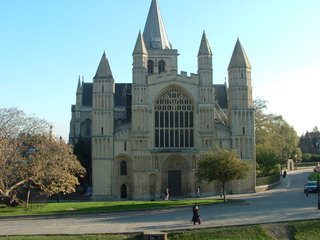
We passed through Rochester some weeks back en route to Dover, and thought then that it would be a good place to come back to for a day visit. We weren't wrong. A great Museum/Castle/Cathedral/old city/Charles Dickens and more.
First stop was the Guildhall Museum -the best provincial museum that we have visited with galleries tracing the ancient times of the area, the middle ages/graphic history of the Hulk ships on the Medway/Charles Dickes association through Pickwick Papers and Great Expectations.
The relics from early times were quite staggering with an exhibit of a 5000 year old stone axe and a collection of Bronze artifacts which had been uncovered by a farmer plowing his field. The sophistication of many of these objects got one thinking about the character of those primaeval people who had developed such skills. Why I wonder did our Aborigines not develop beyond their primitive state?
The diorama of the Hulks used as prisons on the Medway was quite dramatic and chilling and a reminder of the harsh laws which operated in the 17th and 18th century.
Charles Dickens lived in Rochester when he was 5 years old, and spent the last 13 years of his life there. His works abound with mention of features of the city.
On to the Castle which, despite it's 1000 years of existence, remains substantially intact. It was commenced in 1087 and stands 113 feet high dominating the skyline of the City and providing extensive views over the Medway and surrounding Kentish country. It was subjected to seige by King John in 1215 and the rebellious Barons held out for many months until the attackers undermined one of the four towers and set fire to the tunnel with "sacks of pig fat" bringing the tower down. It was eventually replaced, but by a circular tower so that today there are three square towers and one circular!
The Cathedral, England's second oldest, has it's origins in the 7th century and the Norman and late Gothic architechture present an admirable building. Inside we were intrigued by the plethora of plaques to departed members of the Royal Engineers. There were lists of men who had served in the Indian wars and at Waterloo - and we eventually discovered that the Royal Engineers have had their base in the area for many years. As a Local/Acting/Unpaid/Lance Corporal of the RE's during National Service in the 1940's I was quite chuffed to discover this spiritual home!!
In the High Street there is a building called "The Poor Travellers House".This name derives from the poor travellers who were provided with one night's lodging in the six bedrooms built at the back of the Almshouse in the 16th Century. This was due to the generosity of Richard Watts an eminent citizen of Rochester who represented Rochester in parliament for 35 years. His will made provision for "six bedrooms with six good matrices or Flock Bedds and other good and sufficient furniturre to lodge in poor Travellers or Wayfaring men not being rogues or Proctors. "They were also to be given fourpence!! In 1854 Dickens visited the house and it became the subject of his christmas story "The Seven Poor Travellers". The photo top right shows the building.
So after a refreshing Pint of the amber stuff, and a Smoke Salmon and Mackerel pie topped with Welsh Rarebit (yumee) we returned to Langdon Hills well satisfied with the days outing.


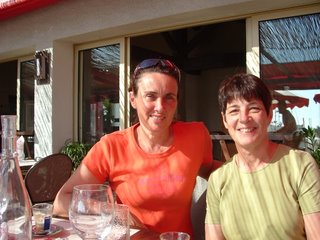

Where to start? Last Tuesday we left Langdon Hills and drove to Stanstead where we were due to depart for Toulon courtesy of Ryan Air. The queue for security checking was horrendous, and in addition there was a further checkpoint where we had to remove our shoes and have them scanned. Finally (an hour later) we were able to relax and await a boarding call. Fog over Europe had disrupted flights but luckily we were off with only a short delay. Flying into Toulon gave us a wonderful view of the South Coast of France and the Mediterranean. As usual I checked the landing procedures (!) and knew we were on final approach, when up we went again! The skipper came on and apologised saying "We came in a bit too high so we are going around to have another go!" Such honesty earned them the name of TryanAir.
Sigalous is a 200 plus hectare estate with chateau, vineyard, olive grove and a variety of activities for adventure type activities - 4 wheel driving tracks, quad and motorbike tracks, conference facilities, gites (cabins), and more.
It is the home of my niece Jeanette and her husband Alain with their 4 1/2 year old son Morgan. They lead a very busy life organising the various facets of their business. Jeanette is an expert 4wd driver (as she later demonstrated) and has been employed by both BMW and Landrover in the promotion of their vehicles in The West Indies and in Africa!! Some girl.
The little Peugot 206 was made available to us and we took off on the Wednesday for Pierrefeu a delightful village nearby built into the side of a hill. Lots of climbing to get magnificent views. Then on to Hyeres and the Presqu'ile De Giens from where we caught a ferry across to the Island of Porquerolles. Driving on the wrong side of the road from the wrong side of the car has always been a challenge for yours truly, but Jeanette gave me a great piece of advice."Don't forget Len that you are driving in the middle of the road" It certainly helped to put things in perspective.!
We had lunch on Porquerolles and then walked some way round the island visiting the old port and the botanical gardens where many Australian plants and trees were thriving in the warm Mediterranean climate. Home to dinner with the family and a glass or two of the Sigalous vintage
The next day we became a lot more adventurous and took off for Lac de Sainte Croix and the Gorges du Verdon, quite a lengthy drive through delightful country. We stopped in Cotignac to have a wander around and couldn't resist going into a Patisserie where I bought a Sausage roll and a cake of unbelievable richness, while Carol enjoyed a provencal onion and anchovy slice and raspberry tart - all very yummy and eaten on a bench by the car park. It was from here that Carol decided to try her hand at driving and of course did so with cool efficiency that left me quite relaxed! The first view of the Lake is amazing - superb blue water shimmering in the sunlight and stretching for miles. The beginnings of the gorge are here and after a minor navigation error we found ourselves traversing the heights of the gorge. This really is one of the wonders of the world.The Gorge is incredibly deep and winds for miles and miles. The road along the top of the gorge affords continual magnificent views and strategically placed stopping bays allowed for plenty of photos. How thoroughly annoyed I was to find on getting home, that the disk in the camera had become corrupted and not one photo could be downloaded.
In the Times newspaper today there is an article about the Gorge headed "Suicide Valley unearths its past". It states that Verdon, one of the world's deepest canyons, and one of Europe's most spectacular tourist attractions, is also a magnet for the suicidal who have driven their cars off the road over the decades. A clean up operation is being undertaken and already 20 tonnes of metal have been cleared. Most of the cars are from 1940 to 1980, after which barriers were installed along the road above the canyon.
A short detour took us into the Medieval village of Trigance - a real look into the past with many of the original buildings still existent and inhabited together with their Sky TV dishes!! As Carol was still driving at this stage the navigator proved useless and we ended up travelling somewhat in the wrong direction. But with little or no fuss "where the f*** are we" - we found our way back on track and then I took over the driving as it got dark. A couple of beers at Sigalous restored the sang froid and a delightful chicken for dinner made for a good night's sleep!
Friday morning - another beautiful day and Jeanette had decided we would all have lunch in Port de Miramar, but suggested that Carol and I visit the town of Bormes-Les- Mimosas. This turned out to be another of those hillside villages, beautifully situated with extensive views from almost everywhere, and a delightful old centre. We walked along ancient streets (alleyways) and found the old town square hidden by two delightful archway entrances. Tourism had helped to preserve the originality of the area and it was a photographic paradise sadly! A short coffee stop in one of the open air cafes and then we drove off to our luncheon appointment. A lovely lunch followed by a walk along the beach - sand and sunshine - just wonderful.
We managed to get lost (again) on the way back to Sigalous - but it took us through a lovely forested area albeit on a fairly narrow road. Jeanette was waiting for us when we arrived. She had told us that she would take us through the estate and demonstrate the 4wd tracks. It so happened that a visiting adventurer had become bogged somewhere up on the tracks and her first task was to recover his vehicle. This she did with remarkable skill - not that the bogged male driver seemed to be very impressed at this WOMAN rescuing him!! Then off we went - Morgan sitting between myself and Jeanette in front of the vehicle - totally relaxed and almost falling asleep as we negotiated waterholes/chasms and rock faces with total ease. Carol was standing in the open back of the truck enjoying herself immensely. The tour of the estate took in the vineyards from which last year 700,000 bottles of the good stuff were harvested. We also saw a bamboo plantation. These bamboos are grown specifically for the manufacture of reeds in America for wind instruments , and the Provence is the only area in the world where they grow to the required diameter.
Saturday - hard to believe it is the last day - our plane leaves at 3.15 and Jeanette insisted that as long as we were at the airport by 2.30 all would be well! So after breakfast we drove into Hyere to visit a typical Provencal market. We could have spent a whole day there just wandering around looking at the wonderful variety of stalls. We bought some cheeses, slavered over the offerings of fish of every description and enjoyed the narrow streets filled with people. Lunch at Sigalous was on the terrace in bright sunshine and the thought of returning to Essex near winter was not pleasant. True to her word Jeanette got us to the airport at 2.20 and this wonderful provincial facility had us ticketed/cleared of passports and security and on the plane in short order.
A wonderful few days - delightful hosts - great memories of Morgan rapt in his animal books and animal video - bantering with Carol in French.